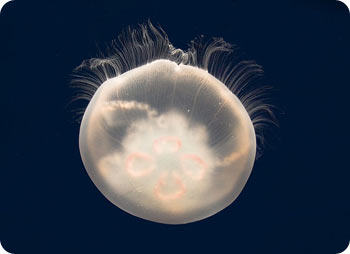200611-jetset.jpg

Adult Moon Jelly (Aurelia aurita) photographed at Monterey Bay Aquarium. Credit: Wikipedia/Dante Alighieri
Marine organisms have many ways of getting around. They wiggle, flap, crawl, or undulate. And some go high-tech: they use jet propulsion.
The marine jet set includes jellyfish, squid, and octopus. All of them create jet thrust by squirting water at high speed, like compressed air squirting out the back of a jet engine.
The body of a jellyfish, known as the bell, is a sack of jelly -- hence the creature’s name. But the bottom of the bell is ringed with a thin layer of strong muscle tissue. When the jellyfish needs to move in a hurry -- to elude a predator or capture prey -- it contracts this ring, expelling water from the bell and pushing the jellyfish forward.
For small jellyfish, this is a one-step process: squeeze and go. But larger jellyfish use a two-step process. After they squeeze, their bells gently relax and reinflate. This flapping motion creates a vortex behind the jellyfish that gives it a second push.
Squids and octopuses also squeeze strong muscles in the upper part of the body, known as the mantle. The muscles shut all of the openings in the body except one, called the funnel or siphon. Water shooting from this opening propels the creature at speeds of up to 25 miles per hour.
Some squid generate enough thrust to push them out of the water. They streamline their bodies and flap their fins, and continue to jet water while in the air. Some species have been seen to reach heights of 20 feet, and to fly almost 200 feet before they return to the water -- jet propelled.

